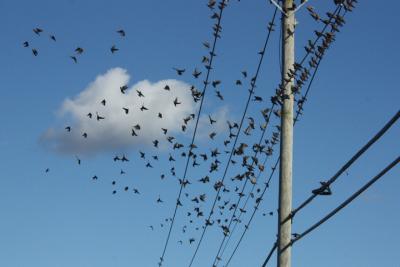Nature Notes: Loners and Flockers

Yesterday, while I was motoring along the Bridgehampton-Sag Harbor Turnpike, a rafter of turkeys crossed in front of me. Later on, at Sagg Pond, I flushed a gaggle of geese. On my way back home after checking out the ocean, a murder of crows flew over on their way to their evening roost in the trees of Barcelona while a herd of deer began congregating in the fields north and south of Stephen Hand’s Path. Then it got dark and wildlife activity subsided.
Why is it that some birds and mammals flock together while others are mostly solitary or in pairs? Through the millions and millions of evolutionary processes, the two different strategies have continued to be perfected such that both types confer excellent chances of survival in a world ruled by predation, parasitism. and poisoning.
Some species have evolved to the point where they are never apart from their own kind; they are referred to as colonial. Take ants, termites, or honeybees: None of them can survive without the company of their own in large numbers. Some fish — herring, silversides, and menhaden — spend their entire life in compact schools of the same species. On the veldt in Africa a lone wildebeest is a goner for sure, but its chances of survival increase 90 per cent when in the company of others.
Flocking is particularly apparent in organisms that migrate long distances for the purposes of feeding and reproduction. There are very few loners among the several antelope species, zebras, cape buffalo, and even elephants that live on the Serengeti. Caribou that ply the tundras of Siberia, Canada, and Scandinavia are rarely found alone. Single musk ox seeking protection from wolves and polar bears in the Arctic cannot form a protective circle to ward off predation.
Many would-be prey, however, fare far better as loners than as congregants. Cottontail rabbits, gray squirrels, white-footed mice, and chipmunks prefer to keep to themselves, except when mating. They are secretive, seeking the protection of brush, burrows, or holes in tree trunks.
While most bird species, such as the neotropical warblers, only flock while migrating, a good many species flock throughout the year, except while breeding. The European starling and pigeon, so common now throughout the Americas, are almost always flocking. A hundred eyes are better than one pair when trying to avoid a swooping merlin or Cooper’s hawk. Starlings and tree swallows are two local species that take group behavior to its highest form, the way some fish species do in the seas. They not only flock when flying from one area to another, they are formation fliers.
When a hawk is spotted, they form tight balls and other near-solid three-dimensional shapes while twisting and turning through the air, bewildering a would-be marauder again and again. They can tighten up and fly so close together that the would-be predator perceives them as a single giant organism, and one not to mess with.
Another kind of gathering is sexual. Except when breeding, and shortly after, some flocks are unisexual. Red-winged blackbirds, grackles, and robins travel north in unisexual flocks, the males arriving on the spring breeding grounds ahead of the females. Does absence make the heart grow fonder?
Almost all reptiles live alone, except when denning up for the winter as many snakes do in temperate and northern America. Frogs, toads, and salamanders only gather together for reproductive purposes.
Many insects, especially those in the fly order, such as stoneflies and mayflies that start out as aquatic larvae then metamorphose into insects with wings, gather together. In certain years and areas, they can completely cover vehicles, roofs, lawns, and streets in thick carpets. Ladybird beetles lead mostly solitary lives except when it comes to winter, when they form tight overwintering colonies near heat sources.
Coral organisms cement themselves together as do ascidians that form spongy mats on hard surfaces. You very rarely find a barnacle on a dock post all by itself. Ribbed mussels and blue mussels cling together by their silky byssal threads. Bats often gather under the eaves of houses or when hibernating close together in caves. Purple martens eschew single nesting boxes while the closely related tree swallows prefer individual boxes to nest in. Bank swallows, say, those that nest in holes in Montauk’s ocean and Block Island Sound bluffs, dig out their burrows in close proximity to each other.
Some predator species, especially wolves, hyenas, and Africa’s wild dogs, cohabit. While it would be difficult for a single wolf to take down a caribou, or one hyena to tackle a zebra, a pack of wolves or hyenas becomes an efficient superpredator.
A different kind of flocking takes place among our resident winter birds. Woodpeckers, chickadees, nuthatches, blue jays, brown creepers, juncos, and others travel together in loose flocks from feeding spot to feeding spot, whether in the woods or on a post in someone’s yard.
Finally we come to humans — gregarious or solitary, we can be both. The thought of gathering together by the hundreds of thousands in Times Square to watch the big ball drop at the stroke of midnight on New Year’s Eve scares the dickens out of me.
I’m a country boy and always will be, but I’m an oddity. Most people are urbanites and feel safer and happier in close proximity to other urbanites. The 10 largest cities in the United States account for more than 10 percent of America’s human population. According to the 2016 World Almanac, 80 percent of our total population is urban. While some can be both loners and joiners, urban and countrified, those who are exclusively city dwellers rule the roost.
Which raises the question: Which is safer, living in a city or in the boondocks? Who lives the longest, I wonder?
Larry Penny can be reached via email at [email protected].
